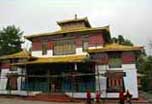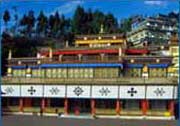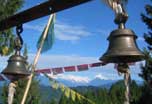| |
 There is more to Sikkim than just
natural beauty. Sikkim does provide a wide potential in tourism
that has yet largely remained unexploited. The perennially
snow-capped mountains, lush green tropical and temperate
forests, gurgling streams and the rich flora and fauna are all
there for the tourist to savor. Sikkimese hospitality tangibly
manifests itself in the intricately designed welcome gates with
pagoda type roofs that are normally located at the entrances of
monasteries an important public buildings. Wayside resting sheds
which Sikkim abounds in also have curved roofs and pillars
around which painted dragons curl themselves. So much so that
even public buildings, powerhouses and other structures tend to
look like huge pagodas in a true blend of typical Tibetan and
modern architectures. Besides the natural beauty that one
continuously beholds while in Sikkim, there are many places that
deserve a special mention. These are given below. There is more to Sikkim than just
natural beauty. Sikkim does provide a wide potential in tourism
that has yet largely remained unexploited. The perennially
snow-capped mountains, lush green tropical and temperate
forests, gurgling streams and the rich flora and fauna are all
there for the tourist to savor. Sikkimese hospitality tangibly
manifests itself in the intricately designed welcome gates with
pagoda type roofs that are normally located at the entrances of
monasteries an important public buildings. Wayside resting sheds
which Sikkim abounds in also have curved roofs and pillars
around which painted dragons curl themselves. So much so that
even public buildings, powerhouses and other structures tend to
look like huge pagodas in a true blend of typical Tibetan and
modern architectures. Besides the natural beauty that one
continuously beholds while in Sikkim, there are many places that
deserve a special mention. These are given below.
Directorate of Handicrafts and Handlooms or Government
Institute of Cottage Industries
Established by Government to promote the manufacturing and
selling of authentic and traditional arts and handicraft,
handlooms and exquisite carpets, blankets and shawls in “Lepcha”
weaves, furniture (Choksies), thankas, paintings, wooden
decoration and bamboo products in authentic Sikkimese designs.
Visiting Hours - Monday to Saturday from 9.30 Am. to 12.30 Pm.
And 1.00Pm to 3.00 PM. Closed on Sundays, Second Saturdays and
Government holidays.
Enchey Monastery
 About 3 km from the centre of town, a small hermitage was
built by lama Druptob Karpo (renowned for his power of flying)
at this spot after he flew here from Maenam Hill in South Sikkim
about more than 200 years ago. During the reign of Sidkeong
Tulku, 1909-1910. The present monastery was built in the form of
Chinese Pagoda. It follows Nyingmapa order. The annual puja is
celebrated with religious masked dances on the 18th and 19th
days of the 11 month of the Tibetan Buddhist calendar
corresponding to the month of December. About 3 km from the centre of town, a small hermitage was
built by lama Druptob Karpo (renowned for his power of flying)
at this spot after he flew here from Maenam Hill in South Sikkim
about more than 200 years ago. During the reign of Sidkeong
Tulku, 1909-1910. The present monastery was built in the form of
Chinese Pagoda. It follows Nyingmapa order. The annual puja is
celebrated with religious masked dances on the 18th and 19th
days of the 11 month of the Tibetan Buddhist calendar
corresponding to the month of December.
Do-drul Chorten (Stupa)
Situated on a hillock, it is a five minutes drive from
Gangtok town. Built by late Trulshik Rimpoche in 1946, head of
the Nyingmapa order and the late Chogyal Tashi Namgyal in 1957
to invoke the Gods for the peace and tranquillity in the State.
Set of Kagyur holy books, relics, complete mantras, rare
mandalas of Dorjee Phurba (Bajra Kilaya) and other religious
objects are found inside the Chorten. A small Chorten known as
Jhang Chub is built beside the Phurba Chorten in memory of
Trulshik Rimpoche who passed away in 1962. Few yards below the
Chorten is the rock known as “DO-TA-PU” or “Stone Horse”. There
is a monastery close by called “Guru Lakhang” with the state of
Guru Padmasambhava and Guru Snong Zisil Gnen, the incarnated one
of the first. Around the Chorten is installed the ‘180’
Mani-Lhakor or prayer wheels. The Chorten has the sacred topped
stupa.
Research Institute of Tibetology
The Namgyal Research Institute of Tibetology is a
world-renowned research centre for Tibetan Buddhism and is well
stocked with rare books and manuscripts on Buddhism. Contains
rare collection of antique like coins, statues, rosaries, antic
documents, brass bells, dorjis, and thankas. Ti has a collection
of almost 30,000 volumes on diverse subjects like astrology,
philosophy, magic and religion. It conducts research in the
fields of language and culture of Tibet. The foundation was laid
in 1957 by His Holiness the Dalai Lama and was inaugurated by
Pandit Jawaharlal Nehru in October 1958. It also has a number of
religious art and craftwork as well as books for sale. It’s vast
wealth of Lepcha, Tibetan and Sanskrit manuscripts attracts
scholars from all corners of the world. The institute is open
from 10.00 AM to 4.00 PM, Monday to Saturday and is closed on
Sunday, Second Saturdays and on Government holidays.
Orchid Sanctuary
It is near Research Institute of Tibetology, where you can
see many of the 454 species of orchid found in Sikkim. The best
time to visit is April-May, July-August and October-November.
Saramsa or Ipecac Garden
About 14 Km from Gangtok besides Ranikhola is this garden
the home of Sikkim’s many exotic orchids and other rare tropical
and temperate plants. Formed and maintained by the Department of
Forest, it is an excellent recreational and beautiful picnic
spot.
Rumtek Monastery
 It is about 24 km From Gangtok nested in a lovely landscape.
The first monastery was built in 1717 At Rumtek by the then
Chogyal Gyurmed Namgyal, but was destroyed by the earthquake and
aging. His Holiness the late 16th Gyalwa Karmapa constructed the
second monastery in 1960. It is the headquarters of the Kagyu-pa
(Red Hat) sect of the Tibetan lamaistic Buddhism. It is an
excellent replica of the original Kagyu headquarters at Tsurpu
in Tibet. It houses some of the world’s most unique art objects,
ancient manuscripts and icons. Above the Rumtek Dharma Chakra
Centre is a hermitage where the monks go into complete seclusion
for meditation for a period of three years. It is about 24 km From Gangtok nested in a lovely landscape.
The first monastery was built in 1717 At Rumtek by the then
Chogyal Gyurmed Namgyal, but was destroyed by the earthquake and
aging. His Holiness the late 16th Gyalwa Karmapa constructed the
second monastery in 1960. It is the headquarters of the Kagyu-pa
(Red Hat) sect of the Tibetan lamaistic Buddhism. It is an
excellent replica of the original Kagyu headquarters at Tsurpu
in Tibet. It houses some of the world’s most unique art objects,
ancient manuscripts and icons. Above the Rumtek Dharma Chakra
Centre is a hermitage where the monks go into complete seclusion
for meditation for a period of three years.
The important chaam (religious masked dance) is performed on the
10th day of the 5th month of the Tibetan Calendar, and presence
eight manifestations of the Guru Rimpoche. This is highly
colourful and spectacular and draws many pilgrims and visitors.
Prayers at about 0400 and 1800 hours.
Botanical Garden of Orchidarium
It is a day outing about 14 km Away from Gangtok with
colourful flowerbeds. Lush green trees and narrow winding paths
near tinkling stream. Orchids thrive here in huge conservation
that forms a part of garden.
Tsuklakhang
The palace monastery or Royal Chapel of the Chogyals opens
only once a year for the civilians in the last week of December
for the Lossong festival when the famous Black Hat dance
portrays the triumph of good over evil. This was once the most
important monastery where all the important national and
religious festival was celebrated here. It was the site of the
coronation ceremonies of the kings of Sikkim, of royal marriages
and of celebration ceremonies of the kings of Sikkim, of royal
marriages and of celebrations to mark victories. Tsuklakhang,
standing on the high ridge has a large and impressive collection
of scriptures. Tsuklakhang is a very elegant structure in
typical Sikkimese style with carved and painted woodworks,
murals, wall hangings and priceless Buddhist treasures. Lavishly
decorated altars hold images of the Buddha, Bodhisattvas and
Tantric deities. Among the important festivals still celebrate
at Tsuklakhang are Pang Lhabsol held in mid September in honour
of Mount Khangchendzonga the guardian deity of Sikkim, Kagyad in
early December, which features a dance – drama enacted by
Buddhist monks, and losar is strictly prohibited.
Deer Park
Embraced by gardens f flowers lies a beautiful Deer Park –
an ideal place to be solitude, beside the Secretariat. Built to
commemorate the Buddha’s reincarnation as a musk deer, it has a
large fielded statue of Buddha under a beautiful canopy in
preaching posture, a replica of the statue at Sarnath in Uttar
Pradesh, where Lord Buddha delivered his first sermon. It is a
popular viewpoint on the edge of the ridge.
White Hall
Built in 1932 in memory of the first Political Officer of
Sikkim, Sir Claude White. Situated on a ridge, it has historical
value only. There is an officer’s club.
Ganesh Tok
 It is at an altitude of 6500 ft. above Gangtok and 7 km
Where a small temple of God Ganesha is nested. Panoramic view of
Gangtok, magnificent and breathtaking view of Khangchendzonga
and Siniolchu can be observed and enjoyed from this spot on a
ridge. A cafeteria serves hot tea, coffee and snacks. It is at an altitude of 6500 ft. above Gangtok and 7 km
Where a small temple of God Ganesha is nested. Panoramic view of
Gangtok, magnificent and breathtaking view of Khangchendzonga
and Siniolchu can be observed and enjoyed from this spot on a
ridge. A cafeteria serves hot tea, coffee and snacks.
Hanuman Tok
It is at an altitude of 7200 ft., about 5 km From Gangtok
where there is a temple of God Hanuman. Panoramic view of
Gangtok and adjoining hills and valleys with Khangchendzonga on
the background can be seen from here. Sunrise can be observed
from here. Night view of the Gangtok city lights is mood
elevating.
Tashi View Point
About 8 km From Gangtok. It is a resting shed. Astounding
view of Khangchendzonga and the Siniolchu Range is the main
attractive of this point. The distant north Sikkim monasteries
are also visible from this point along the North Sikkim highway.
Kabi Longtsok
It is 24 km From Gangtok where the treaty of brotherhood was
signed between the Lepcha chieftain Thekong Tek and the Bhutia
chief Khye Bumsa in the 13th Century.
Phodong Monastery
 It is about 38 km From Gangtok, which belongs to the Kargupa
sect, built by the late Chogyal Gyurmed Namgyal in the first
quarter of the 18th Century. The original monastery has been
rebuilt. The main annual puja is performed here on the 28th and
29th days of the 10th month of the Lunar calendar with religious
dances being the main attraction. Beautiful mural paintings and
frescoes adorn the walls of this monastery. Executed largely in
black, the murals depict various demonic deities dismembering
miscreants in the bowels of hell. It is about 38 km From Gangtok, which belongs to the Kargupa
sect, built by the late Chogyal Gyurmed Namgyal in the first
quarter of the 18th Century. The original monastery has been
rebuilt. The main annual puja is performed here on the 28th and
29th days of the 10th month of the Lunar calendar with religious
dances being the main attraction. Beautiful mural paintings and
frescoes adorn the walls of this monastery. Executed largely in
black, the murals depict various demonic deities dismembering
miscreants in the bowels of hell.
Ralong
Belonging to the karma kagyu order, it was built after the
return of the 4th Chogyal from his Pilgrimage to Tibet. H.H. the
Gyalwa Karmapa performed the 'Rabney' (blessing) on it's
completion from Tsurpu itself, and grains from this ceremony
fell on the ground at Ralong. Between 1975-81 the Government
rebuilt the monastery. The main ceremony falls on the 28th and
29th day of the tenth month of the lunar calendar. When the
'chaams' are performed.
Yuksom
The historical hamlet of Yuksom (1781 m) is situated 42 km.
from Pemayangtse, where the coronation of the first Chogyal
(king), Phuntsog Namgyal was consecrated in 1641 by the three
learned lamas. The wooden altar, throne and a stupa marks this
spot. It is a pine-forested area with crystal clear mountain
lakes.
Labrang Monastery
It is some 2 km Further up hill from Phodong Monastery and
is a much older structure. The Labrang Gompa retains the
original structure and the old mural paintings and frescoes are
fascinating. It belongs to the Nyingmapa sect. This uniquely
architectured Labrang Monastery is one of the major monasteries
of Sikkim.
Tsomgo Lake
A natural lake of Sikkim, which is regarded extremely
sacred. It is approximately 36 km From Gangtok and is at an
altitude of 12,400 ft. Presently
Menmecho Lake
This is another beautiful lake located near the Tsomgo Lake.
It is rich in fish, especially trout, salmon and carp.
Yumthang Valley
It is situated at an altitude of about 11800 ft. and is 149
km From Gangtok. It is covered with rhododendron, shrubs and
trees of various species. The valley is well known for its hot
springs, which is slightly saline in taste, it is colourless,
emits bubbles of sulphated hydrogen gas and the temperature is
106 degrees. It is surrounded by mountains and seems to touch
the heaven, as one has to face vertically upwards to see the
mountaintop. The scenic view is breath taking.
Khechopalri Lake
It is located at a distance of 33 Km away from Pemayangtse.
The name Khechopalri mean' Wishing Lake’ and is considered to be
one of the sacred lakes in Sikkim. The Sikkimese calls it
Tsho-Sho-Tsho. The water is placid and crystal clear. Not a
single leaf can be seen floating and there is an ancient belief
that if a leaf drops on the surface of the water it is picked by
a bird. Khechopalri lake (1780m) lies in a depression surrounded
by prayer flags and forested hills. The tranquillity of the lake
is mood elevating.
Rabdenste Palace Ruins
Rabdenste was the second capital of Sikkim shifted from
Yuksom. The second Chogyal of Sikkim, Tensung Namgyal,
established it in the late seventeenth century. Presently the
Rabdentse Palace in West Sikkim is in ruins, now being preserved
by the Archaeological Survey of India and have been declared as
a monument.
Fambong Lho Wildlife Sanctuary
It is located about 20 km from Gangtok and covers an area of
about 5200 hectares above the road between Singtam and Dikchu.
Pemayangtse Monastery
The premier monastery of Sikkim, Pemayangtse (Perfect
Sublime Lotus) is about 118 km From Gangtok and is situated at a
height of 2085 mtrs. It is the second oldest monastery of Sikkim
and it is of Tantric Nyingmapa order. It was founded furring the
reign of 3rd Chogyal, Chahdor Namgyal in 1705. The ministry
contains numerous antique idols and objects of worship. The
monastery is a three storied structure filled with wall
paintings and sculptures including seven tiered painted wooden
sculpture on the top floor portraying the Mahaguru’s Heavenly
palace ‘Sangthokpalri’ which was completed in a span of five
years, single handily by the late Dungzin Rimpoche. The Chortens
around t he place have however stood the elements of nature. The
ruins are now being preserved by the Archaeological Survey of
India and have been declared as monuments. Annual Chaam dance is
held o n the 28th and 29th day of the 12th month of the Tibetan
lunar calendar. Dressed in costumes of rare magnificence the
lamas represent Mahakala and Guru Drag-dmar. The dance ends on
the third day with the unfurling of the Ghyo-ku – a gigantic
embroidered Buddhist scroll as the devotees bend down.
Phensang
Build in 1721, during the time of Jigme Pawo, it was gutted
by a fire in 1947, and rebuilt in 1948 through the efforts of
the lamas. The main annual function is held here on the 28th and
29th days of the tenth month of the lunar calendar.
Tashiding Monastery
It is about 40km From Gyalshing. It is of Nyingmapa order at
a hilltop that looms up between Rathong River and Rangit River.
It is surrounded by flags and stone plates skilfully carved with
holy Buddhist mantras was ‘ Om Mani Padme Hum” by
Yanchong-Lodil. The main monastery was built in 1717 by Pedi
Wangmo (Ngadak Sempa Chenpo) during the reign of 3rd Chogyal
Chahdor Namgyal, on a spot consecrated by Guru Rimpoche.
Tashiding Monastery (1469m) is considered to be the most sacred
and holiest shrine or Chorten in Sikkim. It is believed that to
merely view the sacred Chorten Thongwa Rangdol and Bumcho (holy
water) is enough to cleanse one of all sins. Lhatsun Chenpo
built the chorten. Bumchu is one of the sacred objects of
worship to the Sikkimese. It is a sacred pot-containing holy,
blessed by a Buddhist saint in the 17th Century, which does not
dry up nor spoil. Today, even after 300 years the water remains
as fresh as before. The sacred ceremony of Bumchu is held on the
15th day of the first Tibetan month, when the Bumchu containing
the holy water is opened for public 'darshan' once a year.
Pilgrims come each spring for the Bumchu or water-pot festival
in February to drink water from the sacred pot to the
gold-topped monastery - Tashiding.
|
|